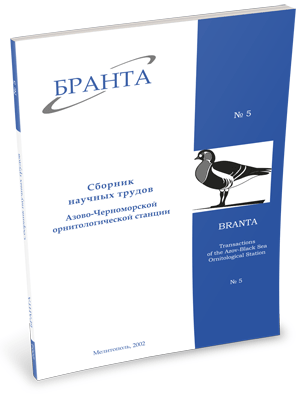
Transactions
of the Azov-Black Sea Ornithological Station



Demise of Great Bustards and other bird species because of their collision with power lines on the wintering grounds.
Andryushchenko Y.A., Beskaravayny Stadnichenko I.S.
Up to 30% of all the European population of Great Bustards or about 80% of Russian population of these birds winters in the south of Ukraine. There the species suffers from many dangers frequently causing the death of individuals. One of many threats is a danger of a bird collision with power lines. The results of the study devoted to this problem are presented in this article.
The works were carried out in the framework of the project of Ukrainian Society for Bird Conservation called “Census of Bustards demise because of their collision with power lines”. The project was fulfilled owing to support of the Embassy of the Netherlands in Ukraine. The authors are also very grateful to Mikityuk A., Dudkin O., Girnyk E. and Grinev V. for their assistance in carrying out the project and participation in its execution.
Basing on the literary analysis, data of inquiries and own data, the authors succeed in gathering information about 19 birds perished over the last decade. The most frequent cause of the collision was weather conditions with low visibility (rain, snow, mist and fog, wind). The field survey was carried out during winter 2001-2002. The census was taken along two control power lines one or three times a week, depending on weather conditions. The route was along both sides of the power lines at the distance of 5-25 m. The length of control plots was about 10 km. During the plots investigation there were counts of all the bird species wintered in the region of the control power lines. Apart from this a sampling investigation of other power lines was done during that winter as well as the public inquiry about facts of bird death because of the collision with power lines.
During this survey 11 cases of reliable collisions of Bustards with power lines were registered. The census under other power lines showed another three cases of Bustard death. Only feathers and bones were discovered. It was connected with eating perished birds by Foxes or Dogs. Crows and Gulls have added weight to this situation, pilfering smaller remains far from power lines. It should be mentioned that many predators (besides the above-mentioned foxes and dogs there are also cats and raccoons) and birds (besides the above-mentioned Сrows and Gulls there are also some birds of prey) specialized in feeding under power lines. They regularly surveyed the territory along power lines searching for food. Having discovered dead bodies of the birds they left practically nothing of them. Moreover snowdrifts hampered the search of Bustard remains.
Two times “feather tracks” were discovered, proving that the birds were not dead but injured because of the collision.
Results of the collision showed that in the south of Ukraine the demise of Bustards because of the collision with power lines is a relatively regular phenomenon at least in places of bird concentration. But the further investigation is necessary to estimate the scale of this phenomenon.
According to decrease in their number the most numerous of 43 birds counted within the control plots were Starling, White-fronted Goose, Skylark, Ruddy Shelduck, Goldfinch, Corn Bunting, Chaffinch, Woodpigeon, Tree Sparrow and Partridge. As a result of the collision mostly those birds die, which are the most mass species during winter (n=46). Under the power lines there were discovered remains of Swans sp.-2, Geese sp.-4, Ducks sp.-1, Hen Harrier-1, Partridge-2, Gulls sp.-8, Owls sp.-2, Carrion Crows-2, Raven-1, other Corvidae species sp.-8, Skylark-6, Starling-2, small Passerines-4. The species of small remains of 4 birds was not determined. Any tendency or “predisposition” to the collision for certain species was not discovered.
Read the paper in a PDF file